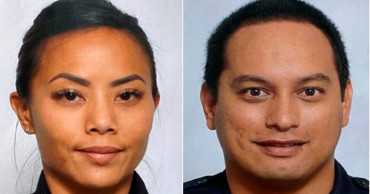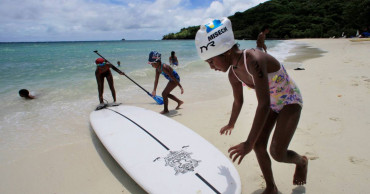Hawaii
World’s largest active volcano Mauna Loa erupts in Hawaii
The world’s largest active volcano was erupting Monday and wasn’t immediately threatening communities on Hawaii’s Big Island, but officials warned residents to be ready for worse.
Many current residents weren’t living there when Mauna Loa last erupted 38 years ago. The U.S. Geological Survey warned the roughly 200,000 people on the Big Island that an eruption “can be very dynamic, and the location and advance of lava flows can change rapidly.”
The eruption began late Sunday night following a series of fairly large earthquakes, said Ken Hon, the scientist-in-charge at the Hawaiian Volcano Observatory.
There’s been a surge of development on the Big Island in recent decades — its population has more than doubled, from 92,000 in 1980.
Most of the people on the island live in the city of Kailua-Kona to the west of the volcano, which has about 23,000 people, and Hilo to the east, with about 45,000. Officials were most worried about several subdivisions about 30 miles to the south of the volcano, which are home to about 5,000 people.
A time-lapse video of the eruption from overnight showed lava lighting up one area, moving across it like waves on the ocean.
The U.S. Geological Survey said that the eruption had migrated to a rift zone — a place where the mountain rock is cracked and relatively weak — making it easier for magma to emerge.
An eruption from the zone could send lava toward the county seat of Hilo or other towns in East Hawaii but it could take the lava weeks or months to reach populated areas.
“We don’t want to try and second-guess the volcano,” Hon said. “We have to let it actually show us what it’s going to do and then we inform people of what is happening ASAP.”
Hawaii County Civil Defense announced that it had opened shelters because it had reports of people evacuating from along the coast on their own initiative.
The average Mauna Loa eruption is not typically prolonged, lasting a couple of weeks, Hon said.
“Typically, Mauna Loa eruptions start off with the heaviest volume first,” Hon said. “After a few days, it starts to calm down a little bit.”
The USGS warned residents at risk from Mauna Loa lava flows to review their eruption preparations. Scientists had been on alert because of a recent spike in earthquakes at the summit of the volcano, which last erupted in 1984.
Portions of the Big Island were under an ashfall advisory issued by the National Weather Service in Honolulu, which said up to a quarter-inch (0.6 centimeters) of ash could accumulate in some areas.
Mauna Loa is one of five volcanoes that together make up the Big Island of Hawaii, which is the southernmost island in the Hawaiian archipelago.
Mauna Loa, rising 13,679 feet (4,169 meters) above sea level, is the much larger neighbor of Kilauea, which erupted in a residential neighborhood and destroyed 700 homes in 2018. Some of its slopes are much steeper than Kilauea’s, so lava can flow much faster when it erupts.
During a 1950 eruption, the mountain’s lava traveled 15 miles (24 kilometers) to the ocean in fewer than three hours.
Tourism is Hawaii’s economic engine but Roth predicted few problems for those on vacation during the eruption.
“It will be spectacular where it is, but the chances of it really interrupting the visitor industry — very, very slim,” he said.
For some, the eruption might cut down on some travel time, even if there is more volcanic smog caused by higher sulfur-dioxide emissions.
Read more: Hawaii's Kilauea volcano erupts, lava fountains form in park
“But the good thing is you don’t have to drive from Kona over to Hawaii Volcanoes National Park to see an eruption anymore,” Roth said. “You can just look out your window at night and you’ll be able to see Mauna Loa erupting.”
Julia Neal, owner of Pahala Plantation Cottages, said the eruption brings some relief after many preparedness meetings, and much wondering about what the volcano will do.
“It’s exciting,” she said. “It’s kind of a relief that it’s happening and we’re not waiting for it to happen.”
A few future guests from the U.S. mainland called Neal “asking me to make a prediction, which I can’t,” she said. “So I said, just stand by.”
Read more: Philippine volcano makes phreatic eruption anew within one week
3 years ago
Hawaii quits coal in bid to fight climate change
The last bits of ash and greenhouse gases from Hawaii’s only remaining coal-fired power plant slipped into the environment this week when the state’s dirtiest source of electricity burned its final pieces of fuel.
The last coal shipment arrived in the islands at the end of July, and the AES Corporation coal plant closed Thursday after 30 years in operation. The facility produced up to one-fifth of the electricity on Oahu — the most populous island in a state of nearly 1.5 million people.
“It really is about reducing greenhouse gases,” Hawaii Gov. David Ige said in an interview with The Associated Press. "And this coal facility is one of the largest emitters. Taking it offline means that we'll stop the 1.5 million metric tons of greenhouse gases that were emitted annually.”
Also read: China promotes coal in setback for efforts to cut emissions
Like other Pacific islands, the Hawaiian chain has suffered the cascading impacts of climate change. The state is experiencing the destruction of coral reefs from bleaching associated with increased ocean temperatures, rapid sea level rise, more intense storms and drought that is increasing the state's wildfire risk.
In 2020, Hawaii’s Legislature passed a law banning the use of coal for energy production at the start of 2023. Hawaii has mandated a transition to 100% renewable energy by 2045, and was the first state to set such a goal.
But critics say that while ending the state's dirtiest source of energy is ultimately a good move, doing so now is not. Renewable sources meant to replace coal energy are not yet on line because of permitting delays, contract issues and pandemic-related supply-chain problems. So the state will instead burn more costly oil that is only slightly less polluting than coal.
“If you are a believer that climate change is going to end because we shut down this coal plant, this is a great day for you," said Democratic state Sen. Glenn Wakai, chair of the Committee on Economic Development, Tourism and Technology. “But if you pay an electricity bill, this is a disastrous day for you.”
Also read: Climate consensus appears near; India objects to coal plans
The end of coal and the additional cost of oil will translate to an increase in electricity bills for consumers who already face the nation's highest energy and living costs. Hawaiian Electric Company had projected ratepayers would see a 7% spike in their bills, but Thursday revised that to 4% because of a drop in oil prices.
“What we’re doing ... is transitioning from the cheapest fossil fuel to the most expensive fossil fuel,” Wakai said. "And we’re going to be subjected to geopolitical issues on pricing for oil as well as access to oil. ”
The AES coal plant closure means Hawaii joins 10 other states with no major coal-fired power facilities, according to data from Global Energy Monitor, a nonprofit advocating for a global transition to clean energy. Rhode Island and Vermont never had any coal-fired power plants.
While Hawaii is the first state to fully implement a ban on coal, a handful of others previously passed laws. The 2015 law in Oregon, the first state to pass a ban, isn't effective until 2035. Washington state's 2020 coal ban starts in 2025. California, Maine and Texas are among states that have restricted construction of new coal-fired plants.
The number of coal-burning units in the United States peaked in 2001 at about 1,100. More than half have stopped operating since then, with most switching to more cost-effective natural gas.
U.S. Energy Information Administration data shows oil generated about two-thirds of Hawaii's electricity in 2021. That makes Hawaii the most petroleum-dependent state, even as it tries to make a rapid transition to renewables.
Hawaii already gets about 40% of its power from sustainable sources including wind, solar, hydroelectric and geothermal.
State Sen. Kurt Fevella, a Republican and the Senate Minority Leader, suggested that Hawaiian Electric Company and other energy corporations should absorb the additional cost of shifting to renewables.
“The fact that Hawaii’s families are already doing what is necessary to reduce their energy uses while still paying the most in the nation for household electricity is unsustainable,” said Fevella. “While I believe utility companies like HECO can do more to reduce the energy burden passed on to Hawaii’s ratepayers, I also believe developers of renewal energy projects should also bear a greater portion of the transmission costs."
Hawaiian Electric Company, the primary distributor of electricity for the state, said it can do little to change the prices to consumers.
“We’re a regulated monopoly,” said Vice President of Government and Community Relations and Corporate Communications Jim Kelly. ”So we don’t set the prices. We don’t make any money on the fuels that we use to generate electricity.”
AES, the operator of Hawaii's last coal plant, has transitioned to creating clean energy and is working on large solar farms across the state, including one in West Oahu that will replace some lost coal energy when completed next year.
“Renewables are getting cheaper by the day," said Leonardo Moreno, president of AES Corporation's clean energy division. “I envision a future where energy is very, very cheap, abundant and renewable."
Sustainable energy experts say getting rid of coal is critical in curbing climate change. While the current renewable landscape is not perfect, they say technologies are improving.
“This is the decade of climate action that we really need to be moving on right now,” said Makena Coffman, University of Hawaii professor and director for the Institute for Sustainability and Resilience. “And so these are available technologies and they might get incrementally better, but let’s not wait 10 years to do it.”
Profits from the increased electricity costs to Hawaii consumers will go mostly to overseas oil producers, said Hawaii's Chief Energy Officer Scott Glenn.
Hawaii’s petroleum is distributed by Par Pacific, a Houston-based company which has traditionally sourced the state's oil from Libya and Russia. But after the invasion of Ukraine, Hawaii halted oil shipments from Russia and replaced it with products from Argentina.
Extending the coal plant's operation would be complicated and costly, Glenn said, noting that the plant has been planning decommissioning for years and would now have to buy coal at market price.
“Coal is going up. It’s getting more expensive,” he said of the supply Hawaii gets from clearcut rainforests in Indonesia. "If we were using U.S. coal, it would not be the cheapest energy source on the grid.”
Why would Hawaii, a small U.S. state in the middle of the Pacific, try to lead the way in moving to sustainable energy?
“We are already feeling the effects of climate change,'" Glenn said. “It’s not fair or right to ask other nations or states to act on our behalf if we are not willing and able to do it ourselves. If we don’t, we drown.”
3 years ago
Hawaii to lift COVID-19 travel quarantine rules this month
Hawaii plans to lift its COVID-19 quarantine requirement for travelers this month, meaning that starting on March 26 those arriving from other places in the U.S. won’t have to show proof of vaccination or a negative test to avoid sequestering themselves for five days.
Hawaii is the only U.S. state to implement a coronavirus quarantine program of this kind.
Gov. David Ige said at a news conference the requirement saved lives and was a major factor in limiting the spread of COVID-19 in the islands. Hawaii has one of the lowest coronavirus infection rates in the nation.
The quarantine period for travelers lasted 14 days when Hawaii first imposed it in March 2020. The state later created testing and vaccination exemptions.
The state screened 11.3 million passengers since the testing exemption was launched in October 2020, Ige said.
Those arriving in Hawaii from outside the country still must adhere to U.S. federal guidelines, which vary depending on American citizenship. International tourists do not need to quarantine but still need proof of vaccination and a negative test.
Read: UK lifts all testing requirements for vaccinated travelers
The governor said he would maintain Hawaii’s indoor mask mandate at least through March 25, and would be evaluating whether to lift it after that. Hawaii is last state in the nation with a statewide mandate in effect.
The governor said state Department of Health will review recommendations of the Centers for Disease Control and Prevention before he decides, Ige said.
Ige said he wants to make sure that public schools will be able to continue with in-person learning. He said more people will be traveling as spring break comes, which could increase the presence of the coronavirus at schools.
“The pandemic is not over. Tragically, we continue to see those that we know and love continue to suffer from COVID-19,” he said.
The governor said he was proud of how the community responded the pandemic.
“It is about the people, place and culture of all of us here, coming from diverse backgrounds but always understanding that there is a bigger reason to be willing to sacrifice individual needs to benefit the community,” Ige said. “And over and over again, we were willing to do that.”
3 years ago
Darwin in a lab: Coral evolution tweaked for global warming
On a moonless summer night in Hawaii, krill, fish and crabs swirl through a beam of light as two researchers peer into the water above a vibrant reef.
Minutes later, like clockwork, they see eggs and sperm from spawning coral drifting past their boat. They scoop up the fishy-smelling blobs and put them in test tubes.
In this Darwinian experiment, the scientists are trying to speed up coral’s evolutionary clock to breed “super corals” that can better withstand the impacts of global warming.
For the past five years, the researchers have been conducting experiments to prove their theories would work. Now, they're getting ready to plant laboratory-raised corals in the ocean to see how they survive in Nature.
“Assisted evolution started out as this kind of crazy idea that you could actually help something change and allow that to survive better because it is changing,” said Kira Hughes, a University of Hawaii researcher and the project's manager.
SPEEDING UP NATURE
Researchers tested three methods of making corals more resilient:
— Selective breeding that carries on desirable traits from parents.
— Acclimation that conditions corals to tolerate heat by exposing them to increasing temperatures.
— And modifying the algae that give corals essential nutrients.
Hughes said the methods all have proven successful in the lab.
And while some other scientists worried this is meddling with Nature, Hughes said the rapidly warming planet leaves no other options. “We have to intervene in order to make a change for coral reefs to survive into the future,” she said.
When ocean temperatures rise, coral releases its symbiotic algae that supply nutrients and impart its vibrant colors. The coral turns white — a process called bleaching — and can quickly become sick and die.
Read:In California, some buy machines that make water out of air
For more than a decade, scientists have been observing corals that have survived bleaching, even when others have died on the same reef.
So, researchers are focusing on those hardy survivors, hoping to enhance their heat tolerance. And they found selective breeding held the most promise for Hawaii's reefs.
“Corals are threatened worldwide by a lot of stressors, but increasing temperatures are probably the most severe,” said Crawford Drury, chief scientist at Hawaii’s Coral Resilience Lab. “And so that’s what our focus is on, working with parents that are really thermally tolerant.”
A NOVEL IDEA
In 2015, Ruth Gates, who launched the resilience lab, and Madeleine van Oppen of the Australian Institute of Marine Science published a paper on assisted evolution during one of the world's worst bleaching events.
The scientists proposed bringing corals into a lab to help them evolve into more heat-tolerant animals. And the idea attracted Microsoft co-founder Paul Allen, who funded the first phase of research and whose foundation still supports the program.
“We’ve given (coral) experiences that we think are going to raise their ability to survive,” Gates told The Associated Press in a 2015 interview.
Gates, who died of brain cancer in 2018, also said she wanted people to know how “intimately reef health is intertwined with human health.”
Coral reefs, often called the rainforests of the sea, provide food for humans and marine animals, shoreline protection for coastal communities, jobs for tourist economies and even medicine to treat illnesses such as cancer, arthritis and Alzheimers disease.
A recent report from the National Oceanic and Atmospheric Administration and other research organizations concluded bleaching events are the biggest threat to the world's coral reefs. Scientists found that between 2009 and 2018, the world lost about 14% of its coral.
Assisted evolution was not widely accepted when first proposed.
Van Oppen said there were concerns about losing genetic diversity and critics who said the scientists were “playing gods” by tampering with the reef.
“Well, you know, (humans) have already intervened with the reef for very long periods of time,” van Oppen said. “All we’re trying to do is to repair the damage.”
Rather than editing genes or creating anything unnatural, researchers are just nudging what could already happen in the ocean, she said. “We are really focusing first on as local a scale as possible to try and maintain and enhance what is already there."
Read:Oldest human footprints in North America found in New Mexico
MILLIONS OF YEARS IN THE MAKING
Still, there are lingering questions.
“We have discovered lots of reasons why corals don’t bleach," said Steve Palumbi, a marine biologist and professor at Stanford University. “Just because you find a coral that isn’t bleaching in the field or in the lab doesn’t mean it’s permanently heat tolerant.”
Corals have been on Earth for about 250 million years and their genetic code is not fully understood.
“This is not the first time any coral on the entire planet has ever been exposed to heat,” Palumbi said. “So the fact that all corals are not heat resistant tells you ... that there’s some disadvantage to it. And if there weren’t a disadvantage, they’d all be heat resistant.”
But Palumbi thinks the assisted evolution work has a valuable place in coral management plans because “reefs all over the world are in desperate, desperate, desperate trouble.”
The project has gained broad support and spurred research around the world. Scientists in the United Kingdom, Saudi Arabia, Germany and elsewhere are doing their own coral resilience work. The U.S. government also backs the effort.
Assisted evolution "is really impressive and very consistent with a study that we conducted with the National Academies of Sciences,” said Jennifer Koss, the director of NOAA's Coral Reef Conservation Program.
“We asked them to gather all the most recent cutting-edge science that was really centered on innovative interventions in coral reef management,” Koss said. “And certainly, this assisted gene flow fits right in.”
MAJOR HURDLES
There are still serious challenges.
Scalability is one. Getting lab-bred corals out into the ocean and having them survive will be hard, especially since reintroduction has to happen on a local level to avoid bringing detrimental biological material from one region to another.
James Guest, a coral ecologist in the United Kingdom, leads a project to show selectively bred corals not only survive longer in warmer water, but can also be successfully reintroduced on a large scale.
“It’s great if we can do all this stuff in the lab, but we have to show that we can get very large numbers of them out onto the reef in a cost-effective way,” Guest said.
Scientists are testing delivery methods, such as using ships to pump young corals into the ocean and deploying small underwater robots to plant coral.
No one is proposing assisted evolution alone will save the world’s reefs. The idea is part of a suite of measures – with proposals ranging from creating shades for coral to pumping cooler deep-ocean water onto reefs that get too warm.
The advantage of planting stronger corals is that after a generation or two, they should spread their traits naturally, without much human intervention.
Over the next several years, the Hawaii scientists will place selectively bred coral back into Kaneohe Bay and observe their behavior. Van Oppen and her colleagues have already put some corals with modified symbiotic algae back on the Great Barrier Reef.
With the world's oceans continuing to warm, scientists say they are up against the clock to save reefs.
“All the work we are going to do here,” said Hawaii's Drury, “is not going to make a difference if we don’t wind up addressing climate change on a global, systematic scale.
“So really, what we’re trying to do is buy time.”
4 years ago
US bans swimming with Hawaii's nocturnal spinner dolphins
U.S. regulators on Tuesday banned swimming with Hawaii's spinner dolphins to protect the nocturnal animals from people seeking close encounters with the playful species.
Swimming with dolphins is a popular tourist activity in Hawaii. Several companies offer tours that take swimmers to areas frequented by dolphins with the aim of giving them an opportunity to get in the water with the animals.
Read: Govt 'working hard' to save dolphins
The National Oceanic and Atmospheric Administration rule under the Marine Mammal Protection Act prohibits swimming with or getting within 50 yards (46 meters) of a spinner dolphin that is within 2 nautical miles (4 kilometers) of the shore of the main Hawaiian Islands. The rule applies to boats, canoes, stand-up paddleboards, drones or other objects.
NOAA also is proposing a regulation that would prohibit entering certain areas between 6 a.m. and 3 p.m. in parts of the Big Island and Maui that are considered essential daytime habitats for spinner dolphins.
Read: Three more dolphin carcasses found off Chattogram coast
Spinner dolphins hunt in offshore waters at night. During the day, they use areas close to shore that have optimal environmental conditions to socialize, nurture their young, hide from predators and rest in preparation for nightly hunting.
Hawaii’s spinner dolphins get their name from their habit of leaping in the air and spinning around. Some scientists say such behavior is not always playfulness and can instead be an attempt to alert others to danger.
4 years ago
Climate-fueled wildfires take toll on tropical Pacific isles
A metal roof sits atop the burned remains of a homestead on the once-lush slopes of Hawaii’s Mauna Kea — a dormant volcano and the state’s tallest peak — charred cars and motorcycles strewn about as wind-whipped sand and ash blast the scorched landscape.
Generations of Kumu Micah Kamohoalii’s family have lived on these lands reserved for Native Hawaiians, and his cousin owns this house destroyed by the state’s largest-ever wildfire.
“I’ve never seen a fire this big,” Kamohoalii said. “Waimea has had fires, many of them before and some maybe a few hundred acres, but not this size.”
The fire has burned more than 70 square miles (181 square kilometers) in the two weeks it has been going. But it wasn’t the first time this area has burned, and won’t be the last. Like many islands in the Pacific, Hawaii’s dry seasons are getting more extreme with climate change.
Read:Wildfire bears down on Montana towns as West burns
“Everyone knows Waimea to be the pasturelands and to be all the green rolling hills. And so when I was young, all of this was always green,” Kamohoalii said. “In the last 10 to 15 years, it has been really, really dry.”
Huge wildfires highlight the dangers of climate change-related heat and drought for many communities throughout the U.S. West and other hotspots around the world. But experts say relatively small fires on typically wet, tropical islands in the Pacific are also on the rise, creating a cycle of ecological damage that affects vital and limited resources for millions of residents.
From Micronesia to Hawaii, wildfires have been a growing problem for decades. With scarce funding to prevent and suppress these fires, island communities have struggled to address the problem.
“On tropical islands, fires have a unique set of impacts,” said Clay Trauernicht, an ecosystems and wildfire researcher at the University of Hawaii. “First and foremost, fires were very rare prior to human arrival on any Pacific island. The vegetation, the native ecosystems, really evolved in the absence of frequent fires. And so when you do get these fires, they tend to kind of wreak havoc.”
But it’s not just burnt land that is affected. Fires on islands harm environments from the top of mountains to below the ocean’s surface.
“Once a fire occurs, what you’re doing is removing vegetation,” Trauernicht said. “And we often get heavy rainfall events. All of that exposed soil gets carried downstream and we have these direct impacts of erosion, sedimentation on our marine ecosystems. So it really hammers our coral reefs as well.”
Pacific island reefs support local food production, create barriers to large storm surges and are a critical part of tourism that keeps many islands running.
The wet season on tropical islands also causes fire-adapted grasses to grow tall and thick, building fuel for the next summer’s wildfires.
“Guinea grass grows six inches a day in optimal conditions and a six-foot tall patch of grass can throw 20-foot flame lengths,” said Michael Walker, Hawaii’s state fire protection forester. “So what we have here are really fast-moving, very hot, very dangerous fires.”
Read: Wildfires in Algeria leave 42 dead, including 25 soldiers
Walker said such non-native grasses that have proliferated in Hawaii are adapted to fire, but native species and shrubs are not.
“While (these wildfires) may not compare to the size and duration of what folks have in the western United States, we burn a significant portion of our lands every year because of these grass fires, and they’re altering our natural ecosystems and converting forests to grass,” he said.
The latest wildfire on Hawaii’s Big Island burned about 1% of the state’s total land, and other islands in the Pacific such as Palau, Saipan and Guam burn even more — up to 10% in severe fire years.
On average, Guam has nearly 700 wildfires a year, Palau about 175 and Saipan about 20, according to data from 2018.
Guam, like many other places, has long used fire as a tool. Farmers sometimes use it to clear fields and hunters have been known to burn areas while poaching.
The U.S. territory’s forestry chief Christine Camacho Fejeran said fires on the island are mostly caused by arson. “So all of Guam’s wildfires are human-caused issues, whether it’s an intentional or an escaped backyard fire or another (cause),” she said.
On average, Fejeran said, 6,000 to 7,000 acres (2,430 to 2,830 hectares) of the island burns each year, amounting to about 5% of its land.
While no homes have been lost to recent wildfires on Guam, Fejeran believes that trend will come to an end — unless more is done to combat the fires.
The island has made some changes in fire legislation, management, education and enforcement. Arson has become a chargeable offense, but Fejeran says enforcement remains an obstacle in the tight-knit community.
Read: 'We fought a great battle': Greece defends wildfire response
Back in Hawaii, last week’s blaze destroyed three homes, but the fire threatened many more.
Mikiala Brand, who has lived for two decades on a 50-acre homestead, watched as flames came within a few hundred yards (meters) of her house.
As the fire grew closer, she saw firefighters, neighbors and the National Guard racing into her rural neighborhood to fight it. She had to evacuate her beloved home twice in less than 24 hours.
“Of course it was scary,” she said. “But I had faith that the strong, the brave and the talented, and along with nature and Akua, which is our name for the universal spirit, would take care.”
Demonstrating the tenacity of many Native Hawaiians in her farming and ranching community, Brand said, “I only worry about what I have control over.”
Down the mountain in Waikoloa Village, a community of about 7,000, Linda Hunt was also forced to evacuate. She works at a horse stable and scrambled to save the animals as flames whipped closer.
“We only have one and a half roads to get out — you have the main road and then you have the emergency access,” Hunt said of a narrow dirt road. “Everybody was trying to evacuate, there was a lot of confusion.”
The fire was eventually put out just short of the densely populated neighborhood, but had flames reached the homes, it could have been disastrous on the parched landscape.
“When you have high winds like we get here, it’s difficult no matter how big your fire break is, it’s going to blow right through,” Hunt said.
Read: Wildfires rampage in Greek forests, cut large island in half
While fires are becoming more difficult to fight because of dry and hot conditions associated with climate change, experts say the Pacific islands still can help prevent these blazes from causing ecological damage and property losses.
“Fire presents a pretty interesting component of kind of all these climate change impacts that we’re dealing with in the sense that they are manageable,” said Trauernicht, the University of Hawaii wildfire expert.
In addition to education and arson prevention, he said, land use — such as grazing practices and reforestation that reduce volatile grasses — could help.
“It’s within our control, potentially, to reduce the impacts that we’re seeing with fires,” Trauernicht said. “Both in terms of forest loss as well as the impacts on coral reefs.”
4 years ago
NASA sends squid from Hawaii into space for research
Dozens of baby squid from Hawaii are in space for study.
The baby Hawaiian bobtail squid were raised at the University of Hawaii’s Kewalo Marine Laboratory and were blasted into space earlier this month on a SpaceX resupply mission to the International Space Station.
Read:Weird ‘living fossil’ fish lives 100 years, pregnant for 5
Researcher Jamie Foster, who completed her doctorate at the University of Hawaii, is studying how spaceflight affects the squid in hopes of bolstering human health during long space missions, the Honolulu Star-Advertiser reported Monday.
The squid have a symbiotic relationship with natural bacteria that help regulate their bioluminescence.
When astronauts are in low gravity their body’s relationship with microbes changes, said University of Hawaii professor Margaret McFall-Ngai, who Foster studied under in the 1990s.
“We have found that the symbiosis of humans with their microbes is perturbed in microgravity, and Jamie has shown that is true in squid,” said McFall-Ngai. “And, because it’s a simple system, she can get to the bottom of what’s going wrong.”
Read:Chinese crew enters new space station on 3-month mission
Foster is now a Florida professor and principal investigator for a NASA program that researches how microgravity affects the interactions between animals and microbes.
“As astronauts spend more and more time in space, their immune systems become what’s called dysregulated. It doesn’t function as well,” Foster said. “Their immune systems don’t recognize bacteria as easily. They sometimes get sick.”
Foster said understanding what happens to the squid in space could help solve health problems that astronauts face.
“There are aspects of the immune system that just don’t work properly under long-duration spaceflights,” she said. “If humans want to spend time on the moon or Mars, we have to solve health problems to get them there safely.”
Read:Spacecraft buzzes Jupiter’s mega moon, 1st close-up in years
The Kewalo Marine Laboratory breeds the squid for research projects around the world. The tiny animals are plentiful in Hawaiian waters and are about 3 inches (7.6 centimeters) long as adults.
The squid will come back to Earth in July.
4 years ago
Shooting kills 2 officers before Hawaii homes catch fire
A Hawaii man with a history of run-ins with police and neighbors was facing eviction when he stabbed his landlord and killed two officers before the house he and two women were believed to be in burned, authorities and neighbors said Sunday.
5 years ago
Palau’s ban on 'reef toxic' sunscreen takes effect
Palau’s strict environmental measures and ban on sun cream harmful to corals and sea life took effect on Wednesday.
6 years ago
Remains of 6 people onboard crashed helicopter found in Hawaii
The remains of six people onboard a helicopter that crashed on its way back from a sightseeing tour in Hawaii have been recovered, local authorities confirmed on Friday.
6 years ago

.jpg)














